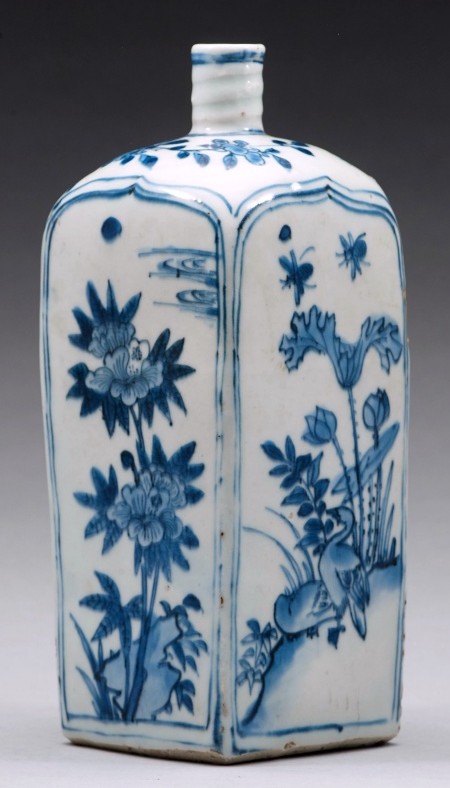
Square bottle, underglaze blue and white decoration. The shape of this bottle derives from European glass examples that were made to store alcohol on ships. The square shape of these glass versions was cleverly designed for easy and efficient storage. The grooved neck on the present porcelain bottle appears to imitates ridging for fitting a screw top but would also have facilitated tying down the stopper. A similar blue and white bottle with panels of floral designs is in the British Museum, London, and is illustrated by Jessica Harrison-Hall in Catalogue of Late Yuan and Ming Ceramics in the British Museum, London, 2001, p., 281, no. 11:12, where the author notes that while the form is based on a Western model, the decoration at this point in the 17th century is still strictly Chinese in character. Late Wanli period (1578–1620) to Tianqi (1621-1627).
The shape is a direct copy of a European model, most probably a glass bottle. Sets of 6, 9 or 12 bottles filled with Geneva (Dutch gin flavored with juniper berries) or brandy, were kept in specially made wooden boxes, called keldertje in Dutch. These are often mentioned in lists of the personal belongings of officers of VOC ships trading with China.
At the Nordic Museum in Sweden, there is an apparent 18th century iron clad oak box with a lock made to hold four square glass bottles, called brännvisschatull (Identifier NM.0117833A-E).
The shape occurs in both Chinese and Japanese, and more rarely in Korean porcelain. The necks are of three kinds. The oldest kind dating to the early 17th century are a spiralling ribbed neck, cut with a spiral grove, that appears to have been made to accommodate a screw top. Later, during the Kangxi period, the openings are typically unglazed and comes with a fitted lid similar to those of tea containers. Often these necks were replaced or fitted with tin or silver stoppers. A third and more uncommon neck is trumped shaped and does not appear to be intended to have a stopper. These are usually called bottle vases if Chinese and Tokkuri (saké bottles) if Japanese.
A